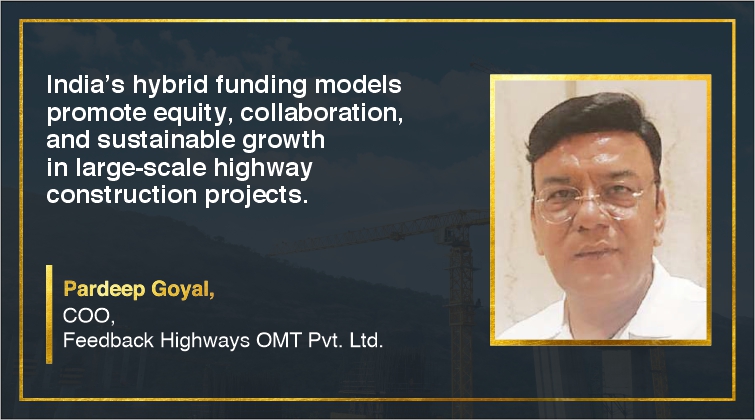India’s highway projects drive economic growth
By Edit Team | July 10, 2023 1:43 pm SHARE

India’s hybrid funding models promote equity, collaboration, and sustainable growth in large-scale highway construction projects.
Indian government targets 60,000 km of highways by 2024, impacting infrastructure, economy, and funding models, says Pardeep Goyal, COO of Feedback Highways OMT Pvt. Ltd.
How will the Indian government’s target to construct 60,000 km of highways by 2024 impact the country’s infrastructure and economy?
Connectivity is crucial for national development, with highways playing a pivotal role. Over the past decade, there has been a significant increase in express routes and connectivity, benefiting industries and transportation logistics. Highways facilitate the transportation of materials, including steel and coal, particularly in villages and towns. Moreover, improved connectivity has made travel more convenient, allowing people to reach their desired destinations easily.
Which equipment and materials are being utilised to construct these New Age routes and highways?
In the hydro sector, the key components for construction begin with road development, followed by aggregates from aggregators, bitumen, and the predominant use of cement. Steel is also an essential component, complementing the construction materials. Furthermore, equipment plays a critical role, including plant equipment like asphalt and ready-mix concrete plants and various types of movable machinery. This machinery and equipment, along with steel plants, cement plants, and refineries, are utilised daily, resembling the conventional emulsion process. Overall, these components and structures contribute to the continuous progress of construction activities in the hydro sector.
How do we ensure construction projects are awarded on merit and ensure transparency in the process?
There is currently a grey area in the process. According to NHAI norms, there are two qualification phases: technical and financial. Contractors must first meet the technical qualification criteria, having completed similar projects. Financially, the lowest bidder is typically awarded the EPC contract. However, due to intense competition and extremely low rates, the quality of work in the industry may need to improve. Therefore, it is suggested that political assessment be considered alongside financial and technical evaluations to ensure improved output rather than solely focusing on the outcome.

What are the key challenges in ensuring road construction project quality? How are these challenges addressed or mitigated?
Contractors such as PPCPs, GMR, and IRP, who are reputable companies in the industry, have their in-house teams to ensure quality on the construction site. Additionally, for all projects, a dedicated team of independent engineers and consultants is appointed by the responsible entity to oversee and verify the project’s quality standards. NHAI’s headquarters team and auditors via the app also perform third-party checks to identify any shortcomings. Furthermore, during the project’s completion, a series of tests are conducted to validate its quality before it is open to the public. Qualified and experienced engineers are deployed to maintain high-quality standards and ensure client satisfaction.
How will the NHAI’s new policy on private investment impact infrastructure development?
The primary road development model relied heavily on the TOT (Toll-Operate-Transfer) model and transport pods. However, due to the equity challenges developers face, the TOT model has gradually phased out, increasing the emphasis on EPC (Engineering, Procurement, and Construction) contracts with government funding. The government has introduced the PPT (Public-Private Partnership) and EPG (Engineering, Procurement, and Construction + Hybrid Annuity) hybrid models to address equity concerns. These models involve a combination of contractor and company equity, particularly for large-scale highway construction projects. Securing construction funds remains challenging, but introducing foreign investments and acquiring completed projects under the TOT model with a one-time payment over a 20-year contract period has helped alleviate this issue. The responsibility for funding the TOT projects now lies with the acquiring entity.
For more details, visit: https://feedbackinfra.com/
Cookie Consent
We use cookies to personalize your experience. By continuing to visit this website you agree to our Terms & Conditions, Privacy Policy and Cookie Policy.





















